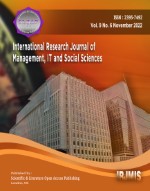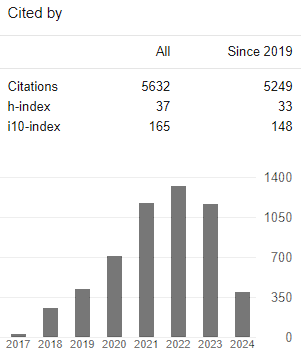Influence of digital media on student practice of the faculty of philosophy, letters and educational sciences
Keywords:
digital media, educational sciences, influence, letters, student practiceAbstract
The objective of this study is to determine the influence of digital media on student practice at the Faculty of Philosophy, Letters and Sciences of Education, given that it is of vital importance to guarantee that the infrastructure of digital media, keeping up with the current development of teaching and learning, in addition, educators and students should be encouraged to enjoy more in the use of these tools. The methodology applied in the research is descriptive, exploratory, field, and explanatory, with a mixed approach, that is, qualitative and quantitative, a structured survey was applied on a Likert scale, applied to 245 students. A high reliability of 0.842 was obtained through the SPSS statistic, which shows that digital media have an influence on student practice, generating benefits in the learning-teaching process.
Downloads
References
Aguirre, F., Destercke, S., Dubois, D., Sallak, M., & Jacob, C. (2014). Inclusion–exclusion principle for belief functions. International journal of approximate reasoning, 55(8), 1708-1727.
Amar, V. (2010). La educación en medios digitales de comunicación. Pixel-Bit. Revista de Medios y Educación, 2010,(36): 115-124.
Appleton, T. G., Clark, H. C., & Manzer, L. E. (1973). The trans-influence: Its measurement and significance. Coordination Chemistry Reviews, 10(3-4), 335-422. https://doi.org/10.1016/S0010-8545(00)80238-6
Ballesta Pagan, J., & Céspedes Ventura, R. (2016). Educación para los medios en un entorno digital. Investigación-acción en compensación educativa. Revista Lasallista de Investigación, 13(1), 156-165.
Cantos, U. C., Chilan, Y. T., & Zambrano, Ángela H. (2021). Traditional pedagogical trends and their impact on the decline in the student population. International Journal of Social Sciences and Humanities, 5(3), 243–252. https://doi.org/10.53730/ijssh.v5n3.2024
Collado, M. C., Rautava, S., Aakko, J., Isolauri, E., & Salminen, S. (2016). Human gut colonisation may be initiated in utero by distinct microbial communities in the placenta and amniotic fluid. Scientific reports, 6(1), 1-13.
Denckla, M. B., & Rudel, R. (1974). Rapid “automatized” naming of pictured objects, colors, letters and numbers by normal children. Cortex, 10(2), 186-202. https://doi.org/10.1016/S0010-9452(74)80009-2
Elche Larrañaga, M., & Yubero, S. (2019). La influencia del hábito lector en el empleo de internet: un estudio con jóvenes universitarios. Investigación bibliotecológica, 33(79), 51-66.
García-Ruiz, R., & Pérez Escoda, A. (2019). Empower citizens through education in digital media.
García-Valcárcel Muñoz-Repiso, A. (2016). Recursos digitales para la mejora de la enseñanza y el aprendizaje.
Guerrero, F., & Mateo, R. (2021). Metodologías de aprendizaje para ejecutivos. Análisis comparativo del aprendizaje social y del método del caso. Academia Y Virtualidad, 14(2), 57-74.
Hernandez, R. M. (2017). Impacto de las TIC en la educación: Retos y Perspectivas. Propósitos y representaciones, 5(1), 325-347.
Hernández-Sampieri, R., Fernández Collado, C., & Baptista Lucio, P. (2018). Metodología de la investigación (Vol. 4, pp. 310-386). México: McGraw-Hill Interamericana.
Khang, H., Kim, J. K., & Kim, Y. (2013). Self-traits and motivations as antecedents of digital media flow and addiction: The Internet, mobile phones, and video games. Computers in Human Behavior, 29(6), 2416-2424. https://doi.org/10.1016/j.chb.2013.05.027
Koizumi, H. (2004). The concept of ‘developing the brain’: a new natural science for learning and education. Brain and Development, 26(7), 434-441. https://doi.org/10.1016/j.braindev.2003.09.011
Lino, M. M. B. ., Barreiro, M. N. Z. ., Baque, P. G. C. ., Cevallos, M. A. M. ., & Parrales, E. B. A. . (2020). Evaluation focused on processes to improve the academic performance of students. International Journal of Social Sciences and Humanities, 4(3), 160–167. https://doi.org/10.29332/ijssh.v4n3.515
Lorido, M. P. (2005). Nuevas tecnologías y educación. Cadernos de Psicopedagogia, 5(9), 00-00.
Moreira, M. A. (2004). Los medios y las tecnologías en la educación. Piramide Ediciones Sa.
Moreno-Ger, P., Torrente, J., Bustamante, J., Fernández-Galaz, C., Fernández-Manjón, B., & Comas-Rengifo, M. D. (2010). Application of a low-cost web-based simulation to improve students’ practical skills in medical education. International journal of medical informatics, 79(6), 459-467. https://doi.org/10.1016/j.ijmedinf.2010.01.017
Nagh, M. (2005). Investigation methodology. mexico: noriega.
Petko, D. (2012). Teachers’ pedagogical beliefs and their use of digital media in classrooms: Sharpening the focus of the ‘will, skill, tool’model and integrating teachers’ constructivist orientations. Computers & Education, 58(4), 1351-1359. https://doi.org/10.1016/j.compedu.2011.12.013
Posligua Guayamabe, E. N. (2018). Rol que desempeñan los medios digitales locales y su influencia en los estudiantes de quinto semestre de la carrera de Comunicación Social de la Universidad Técnica de Babahoyo (Bachelor's thesis, BABAHOYO: UTB, 2018).
Reguera, A. (2008). Metodología de la investigación lingüística: prácticas de escritura. Editorial Brujas.
Rivoir, A., Morales, M. J., & Casamayou, A. (2019). Usos y percepciones de las tecnologías digitales en personas mayores. Limitaciones y beneficios para su calidad de vida. Revista Austral de Ciencias Sociales, (36), 295-313.
Sora, C. (2016). Temporalidades digitales: análisis del tiempo en los new media y las narrativas interactivas. Temporalidades digitales, 1-262.
Story, M., Neumark-Sztainer, D., & French, S. (2002). Individual and environmental influences on adolescent eating behaviors. Journal of the American Dietetic association, 102(3), S40-S51. https://doi.org/10.1016/S0002-8223(02)90421-9
Tulbure, C. (2012). Learning styles, teaching strategies and academic achievement in higher education: A cross-sectional investigation. Procedia-Social and Behavioral Sciences, 33, 398-402. https://doi.org/10.1016/j.sbspro.2012.01.151
Vescio, V., Ross, D., & Adams, A. (2008). A review of research on the impact of professional learning communities on teaching practice and student learning. Teaching and teacher education, 24(1), 80-91. https://doi.org/10.1016/j.tate.2007.01.004
Yen, A. C., Hirst, D. E., & Hopkins, P. E. (2007). A content analysis of the comprehensive income exposure draft comment letters. Research in Accounting Regulation, 19, 53-79. https://doi.org/10.1016/S1052-0457(06)19003-7
Published
How to Cite
Issue
Section
Copyright (c) 2022 International research journal of management, IT and social sciences

This work is licensed under a Creative Commons Attribution-NonCommercial-NoDerivatives 4.0 International License.
Articles published in the International Research Journal of Management, IT and Social sciences (IRJMIS) are available under Creative Commons Attribution Non-Commercial No Derivatives Licence (CC BY-NC-ND 4.0). Authors retain copyright in their work and grant IRJMIS right of first publication under CC BY-NC-ND 4.0. Users have the right to read, download, copy, distribute, print, search, or link to the full texts of articles in this journal, and to use them for any other lawful purpose.
Articles published in IRJMIS can be copied, communicated and shared in their published form for non-commercial purposes provided full attribution is given to the author and the journal. Authors are able to enter into separate, additional contractual arrangements for the non-exclusive distribution of the journal's published version of the work (e.g., post it to an institutional repository or publish it in a book), with an acknowledgment of its initial publication in this journal.
This copyright notice applies to articles published in IRJMIS volumes 7 onwards. Please read about the copyright notices for previous volumes under Journal History.












